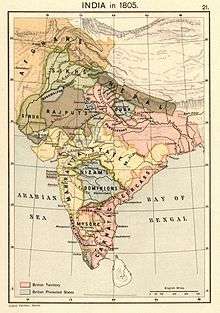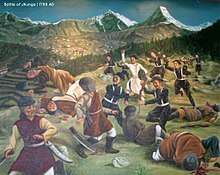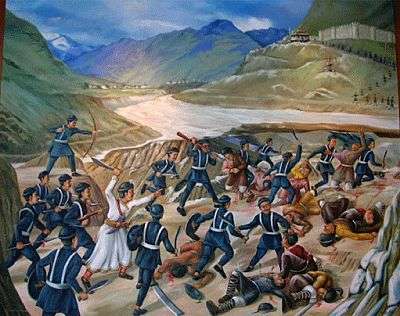Greater Nepal
Part of a series on the |
|---|
| History of Nepal |
 |
|
| Timeline |
|
|
Greater Nepal (Nepali:विशाल नेपाल) or Akhand Nepal (अखण्ड नेपाल) are irredentist terms literally meaning "Undivided Nepal"
History
Gurkhas were ruling in Nepal. From 1767 onwards, they extended their power over the hills and valleys of Nepal. They were ruling on Feudal basis and soon became powerful. They marched into the Kumaun and Gangetic Plains and raided in the British Territories.
The British had recently acquired the lands of Nawab of Oudh and Gorakhpur, Sikkim were on the front. The dispute was because of no fixed boundary. The war ended in a defeat of Gurkhas. The British army marched from Patna to Kathmandu and finally dictated the terms of Treaty of Sugauli, which defined the English relations with Nepal.
Gurkhas lost control over Sikkim, the territories of Kumaon and Garhwal, and most of the lands of the Terai; the British East India Company promised to pay 200,000 rupees annually to compensate for the loss of income from the Terai region.[1]
Unification campaigns by Shah kings


King Prithvi Narayan Shah (1723–75) of the Shah dynasty decided to enlarge the kingdom that was confined to the small Gorkha region of Nepal and had an area of just 2,500 square kilometres (970 sq mi). He defeated major principalities in wars and unified them under his rule starting from the 1740s ending with shifting of his Gorkha Kingdom’s capital from Gorkha region to Kathmandu in 1769. He then attacked and absorbed dozens of other small principalities of Nepal area to his Gorkha kingdom. After his death in 1775, his eldest son Pratap Singh Shah continued defeating other smaller princes and absorbing their fiefdoms. Pratap Shah died at the age of twenty-five in 1777. Then Prithvi Narayan Shah’s second son, Bahadur Shah, ruled until 1794.[2]
Victory over Kumaon, Garhwal and Kangra
The Gorkha army invaded Kumaon Kingdom and occupied it in 1790–91.[3][4] Then the Gorkha army invaded Garhwal Kingdom and occupied it in 1804 after defeating its King Pradyuman Shah. In 1806, the Gorkha army absorbed all the small kingdoms like Sirmudh state, Hindur and Besahar lying across the Garhwal and up to Satluj River. In this way, the Gorkhas controlled the hilly regions such as Nainital, Almora and Dehradun without crossing the Satluj River. However, when the Gorkhas crossed the Satluj river, the Gorkha's attack on Kangra and siege of Kangra Fort west of Satluj river was repulsed by the Kangra king with help from Maharaja Ranjit Singh of Punjab in 1809. Later the Gorkha army absorbed Kangra and extended the kingdom to Ravi river, India. This could not last long as Nepal signed Sugauli treaty.
Victory over Sikkim and Darjeeling
Previously Darjeeling formed a part of dominions of the Raja of Sikkim, who had been engaged in an unsuccessful warfare against the Gorkhas. From 1780 the Gorkhas continually made inroads into Sikkim. Sikkim lost most of its land to Nepal and by the beginning of the 19th century, the Gorkhas had overrun Sikkim as far-eastward as the Teesta and had conquered and annexed the Terai.[5]
Conflict, War and Aftermath
Nepal had conflict with its northern neighbors with Tibet and China over trade dispute and its government had renounced all claims of influence in Tibet and maintained a policy of non-intervention in its affairs whereas Nepal fought war with East India Company over border dispute.
Conflict with Tibet and China

During the Sino-Nepalese War, Nepal invaded Tibet and robbed Tashilhunpo Monastery in Shigatse. Alarmed, the Qianlong Emperor of the Chinese Qing Dynasty appointed Fuk'anggan commander-in-chief of the Tibetan campaign; Fuk'anggan signed treaty to protect his troops thus attaining a draw.[6]

Later Nepalese–Tibetan War was fought from 1855 to 1856 in Tibet between the forces of the Tibetan government (Ganden Phodrang, then under administrative rule of the Qing dynasty) and the invading Nepalese army resulting victory of Nepal.[6]
Conflict with British East India Company
The Anglo-Nepalese War (1814–16) was fought between the Kingdom of Gorkha (present-day Federal Democratic Republic of Nepal) and the East India Company as a result of border disputes and ambitious expansionism of both the belligerent parties. The war ended with the signing of the Treaty of Sugauli in 1816, which ceded around a third of Nepal's territory to the British.
The British were the invading forces, while the Nepalese maintained a defensive position. The British attacked in two successive waves of invasion. It was the most expensive war waged during the governorship of Lord Moira.
Sugauli Treaty
The East India Company had come to rule much of north India by the time the Gurkhas attacked kingdoms in South Asia. The Company became the de facto ruler of South Asia east of Satluj river in place of the Moghuls, Marathas and other kings, especially after defeating the Marathas in 1803 in Second Anglo-Maratha War. After firmly establishing its rule over Delhi in 1803, the Company attacked the Gorkhas and repulsed them from Kumaon Kingdom and Garhwal Kingdom in the area west of Kali river and in Sikkim and north Bengal east of Teesta river by 1815. The Gorkhas were forced to accept a peace treaty with the British (the Sugauli Treaty) in 1816.
Present-day view
There is not any official claim by Government of Nepal or any political party of Nepal to take back the ceded territory to British East India Company by Nepal which is now territory of Republic of India.
Pushpa Kamal Dahal, the chairperson of Maoist party, who spent 10 years of his life in India after being declared a terrorist by the Nepalese government, after becoming PM of Nepal said in an interview with Times of India in 2005 that Greater Nepal was a "media-created stunt".[7].
See also
References
- ↑ "Gurkha war 1814-16". GKToday. 5 June 2011. Retrieved 9 July 2017.
- ↑ "Timeline of the Unification of Nepal (1744-1791)". Karma99. Retrieved 9 July 2017.
- ↑ "Kumaon and Garhwal Coin History". Uttarakhand Worldwide.
- ↑ "The Enclosing of Nepal". countrystudies.us. U.S. Library of Congress.
- ↑ "History of Darjeeling". Government of Darjeeling.
- 1 2 http://www.nepalarmy.mil.np/history.php?page=three
- ↑ Pervez Iqbal Siddiqui (25 October 2005). "Nepal Maoists claim parts of India". Times of India.
External links
- "Important Dates in the History of Uttarakhand". Bell Infotech Systems. Archived from the original on 20 December 2016.
- Border Nepal – Border Management of Nepal
- "The Gurkhas – origin, exploration and expansion". Darjeeling Times. 16 April 2011. Archived from the original on 3 November 2013.
- "Greater Nepal official site" (in Nepali).